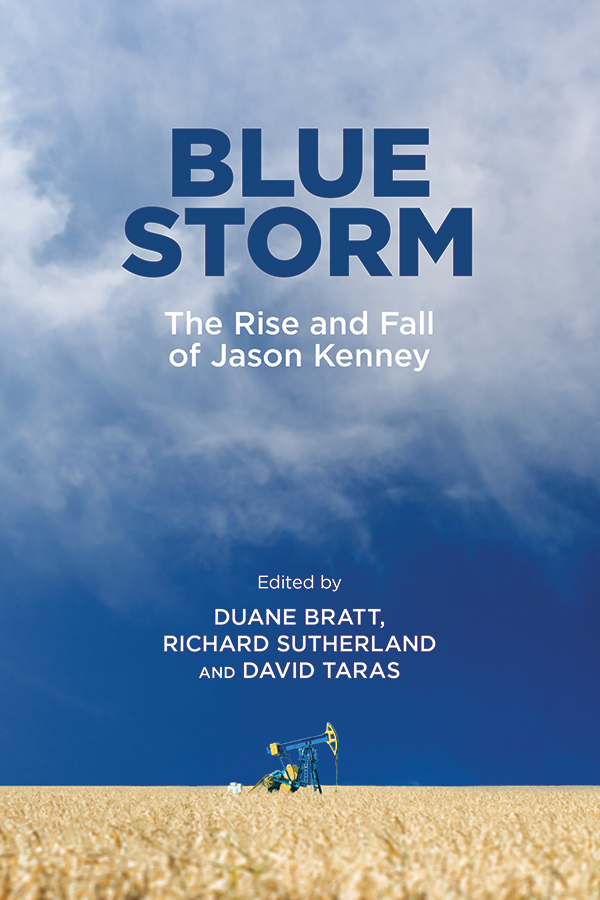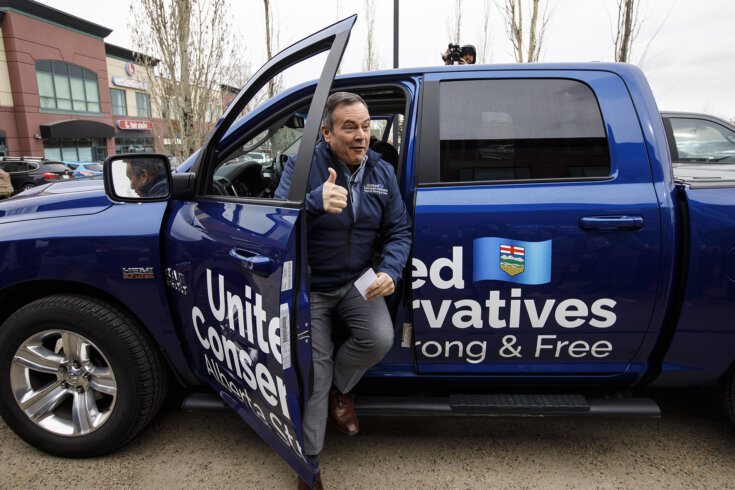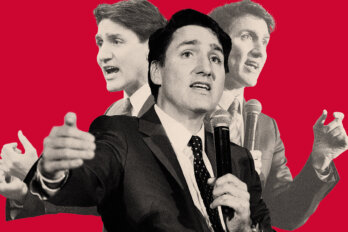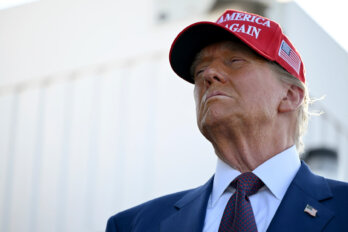 Excerpted from Blue Storm: The Rise and Fall of Jason Kenney
Excerpted from Blue Storm: The Rise and Fall of Jason KenneyA pickup truck invokes power. You can tow house-sized travel trailers, livestock, other vehicles, and building materials. A truck portrays independence: you’re your own man—and yes, a truck is gendered. As the preponderance of advertising and country songs emphasizes, pickup trucks are semiotically a man’s vehicle, even though the gender balance in pickup truck ownership is approaching equality.
Jason Kenney chose a truck early in his rise to power in Alberta. In fact, it was a signature object from the start. Following the 2015 election victory of the New Democratic Party, led by Rachel Notley, against a conservative movement fractured into the Wildrose Party and the Progressive Conservative Party, there was general recognition among conservatives of the need to “unite the right” to effectively challenge Notley in the 2019 Alberta election. In August 2016, Jason Kenney took up the challenge and launched the “Unite Alberta Truck Tour,” visiting all eighty-seven Alberta constituencies over the following months in a blue Dodge 1500 pickup truck. Ultimately, he was successful—merging the PC and the Wildrose Party into the United Conservative Party.
The blue Dodge Ram rolled out again for the 2019 election. Using the same truck with new decals, Kenney criss-crossed the province, talking about “jobs, economy, and pipelines”—a powerful message in a province in the midst of an oil downturn. Mostly eschewing a campaign bus, he used the vehicle to arrive at campaign stops, sometimes jumping out to greet crowds while the truck was still rolling. The truck led him to victory: he literally rolled right inside UCP headquarters for his election night victory speech. A photo of him that night—leaning out of the window, waving as the truck drives through the crowd inside the Calgary convention centre—became emblematic of the decisive election. Since the 2019 victory, the truck has made periodic appearances. It was, for example, taken out for events following the June 2021 “Open for Summer” announcement during the COVID-19 crisis, even becoming Kenney’s Twitter profile picture. The truck went into hiding as pandemic deaths surged in September 2021, expunged even from the premier’s Twitter profile picture.
In 2016, Kenney’s path to power was beset on all sides. To the right, he found himself contesting the fractured base, and he vowed to bring homogeneity back to conservatives: to create a unified conservative party. To the left, if he was successful, he needed to confront the new pluralism and perceived elitism of the urban, liberal, and environmentalist NDP. Kenney proposed an explicit platform that promised both unity and confrontation. He also signalled a return to an Alberta of populist lore: prosperous, maverick, masculine, and rooted in settler culture. To help him create and maintain this neoliberal populist myth of Alberta, he stepped into a blue Dodge Ram. Kenney may not have anticipated, however, how quickly that image would run out of gas.
In the myth of Alberta exceptionalism, Alberta is a maverick province, populated by mavericks. Aside from Quebec, few provinces have expressed a desire to diverge from the others as much as Alberta has. The obvious distinctiveness of its oil-based economy, its physical remoteness from other population centres in Canada, and its social conservative values have all fed into the province’s sense of itself as set apart. Alberta’s individualist trope has even culminated, among other things, in a permanent exhibit at the Glenbow Museum—Mavericks: An Incorrigible History of Alberta. In this myth of exceptionalism, Albertans thrive through personal enterprise more than social endeavour. While the province’s early cowboy and homesteader history is rife with left-wing politics (including the formation of public health care, pro-labour legislation, and social credit theory), this ended with the premiership of Ernest Manning and a seemingly permanent ideological shift toward conservativism.
A pickup truck reflects that shift. It’s a vehicle that removes limits and invokes pioneering homesteader themes. A truck is emancipation from cramped public transit, offering instead the open road. A truck invokes themes of abundance. No longer do overflowing trunks pose a problem; a truck answers the question of how to bring home IKEA purchases or lumber or the bacon. A truck is a necessary tool, and logical consequence, of natural resource extraction. You both need and generate abundance when you drive a truck. Indeed, the myth of Alberta exceptionalism is imbued with an independence derived from the prosperity of natural resource extraction. This, too, combines with the populist myth that Alberta and Albertans support themselves within confederation and individually (through private enterprise, oil, and cattle). This mythical veneration of private enterprise and resource extraction fosters an inherent antagonism toward those who rely on the government for support and has galvanized resentment in Alberta toward provinces that need support—typified by the resentment toward recipients of equalization payments like Quebec and toward politics (and politicians) that are viewed as “socialist.” Notley’s NDP, for example, or Trudeau’s Liberals. When Kenney drives his truck, he sends a message that Alberta is resource(full), unique in its capability and prosperity.
With this identity of individualism and labour come expectations of autonomy. The populist myth of Alberta demands a greater sovereignty over its natural resources and economy and control over federal institutions. Such values enmesh with the symbology of a truck, an iconic vehicle providing mobility and motricity to its owner. The truck is not the public transit of confederation; it is an icon of personal sovereignty, an empowerment to choose one’s own destination and route, pavement or not, with the ability to take along for the ride as much cargo as you’d like . The personal sovereignty manifested in the desire for a pickup truck is a proxy for the desire for a greater say in confederation. As such, the myth of Albertan sovereignty finds voice in a call for non-federalist alliances and pro-oil stances. To that end, Kenney’s promise that his “Dodge Ram would do the job better than a Prius” speaks simultaneously in opposition to a politics of social inclusion, federal allegiance, and environmental stewardship. Kenney’s truck distinctly counters the perceived left-wing environmentalism associated with Prius ownership, since, as author Sarah McFarland Taylor writes, a Prius is a “visible marker of moral commitment and ecopiety.” Kenney’s truck reaffirms and undercuts a perceived environmentalist smugness and elitism and reaffirms the capacity of Alberta to go it alone.
The truck also signals a shift in gendered leadership. A pickup truck is more expressly a masculine symbol and plays into Kenney’s political antagonism against both Trudeau and Notley. Pickup advertisements routinely emphasize the gendered expectation of truck ownership. As Chris Lezotte writes in his 2019 paper about the rise of female truck drivers in the US, while “women are the fastest growing segment of pickup truck buyers, they have been notably absent in truck advertising.” Conversely, “the Prius may technically fulfill the needs of much of an individual’s heavy work, or even everyday lifestyle, but it does not fulfill the accompanying need: being masculine.” Kenney’s truck, therefore, reaffirms that need, setting his non-environmentalist rule against the green policies of both Notley and the self-professed feminist leadership of Justin Trudeau.
The truck, if taken as totemic of certain conservative ideas, does not adapt well to changing political realities. By adopting the vehicle as symbol, Kenney tied himself to a set of constraints that limited his ability to govern effectively—especially in an increasingly complex political environment. Ultimately, Kenney was elected, at least partially, on the depth of the populist myths that enriched the symbology of the blue truck. But the “blue truck” approach is not always the most expedient nor the most effective remedy for Alberta’s political challenges.
While Kenney and the truck were an ideological unit during his run for leadership and the subsequent 2019 election that took the UCP to power, cracks began to emerge in the bond. In a series of policy reversals, the UCP government has diverged several times from the “true blue” conservative values manifested in the truck.
One of the first reversals was a policy on removing dozens of parks from the provincial park system, reverting some to Crown land and allowing others to be operated by private partners. The policy was ultimately stymied by widespread outcry. On Crown land in Alberta, off-road driving is generally allowed—in provincial parks, not so much. The initiative to convert these lands to ideal habitat for blue trucks was defeated.
Another major policy reversal was on coal mining. A large-scale mining project, promoted by an Australian mining company, was the standard-bearer for a larger policy that would have allowed coal mining on the eastern slopes of the Albertan Rocky Mountains. Coal mining and jobs—linked strongly to blue truck ideology—seemed to be a policy that would resonate with Kenney’s conservative base. But the predictable opposition from the left-leaning environmental lobby was unexpectedly joined by small-town councils and ranchers concerned about pollution and the destruction of a landscape that their livelihood depended upon. Kenney misread his base: blue truck drivers love the eastern slopes as they are.
The COVID-19 pandemic has been the most polarizing reversal of all. Throughout the pandemic, Kenney was slow to implement restrictions and fast to rescind them. These policies, seemingly an effort to maintain the support of his right-leaning base, were blamed for the deaths of some Albertans who would have survived under more protective policies. Kenney justified this course of action under two auspices: the economic cost of lockdowns and personal freedoms infringed by public health measures. When restrictions were finally imposed, there was hesitation in enforcing them, culminating in a series of high-profile evangelical Christian clergy and small business owners flouting the rules. As the death toll mounted and hospitals filled up, an untenable situation developed between the government and the scofflaws, resulting in a series of high-profile arrests that galvanized the right wing against Kenney.
Paradoxically, attempts to deliver policy that would resonate with these right wingers resulted in delays in implementing restrictions in the second, third, and fourth waves and ultimately led to the need for much harsher restrictions than were required in more moderate and leftist provinces. Weekly anti-restriction protests—predominately attended by right-wing, anti-vaccine, and anti-masking demonstrators—continue, seemingly regardless of the policy that the government adopts.
In each of these reversals (parks, coal, and COVID-19), Kenney had to get out of the truck, attend to business, and try to get back in. Each time this manoeuvre was performed, the social licence for Kenney’s use of the blue truck diminished.
While the blue truck imagery propelled Kenney to power, the same imagery made it difficult for him to shift to the centre of the political spectrum. Although his policy reversals indicated some attempts to shift left, he did so at the peril of alienating right-wing elements of the party he had “united” on his truck tours. And given his identity that was intentionally linked to the blue truck motif, he had the difficult task of endearing himself to centrist moderates. Adopting a symbol of masculinity, of purposeful antagonism, and of the oil sector left an indelible mark that limited his ability to shift his base to more moderate supporters. At the beginning of his decline and in the midst of the anti-restriction caucus insurrection, Kenney realized the limitations of his chosen symbology, allegedly saying he wanted a “new base.” Further challenging Kenney was a growing segment of Albertans that no longer identified with the blue truck ideology. Instead, they saw the truck as worn, troubled, antiquated.
Any symbol brings risks. While it can communicate more succinctly than words, its meaning predates its contemporary usage. No one person can control the meaning of a symbol, especially one as rich and nuanced as a blue pickup truck. Instead, the symbol may shape discourse in an unpredictable way, connecting current actions to scenarios of the past and providing an unanticipated lense through which to view current events. As Kenney discovered, this connection can be both constraining and difficult to sever.
One of the least obvious details in Kenney’s historic blue truck entrance to the Calgary UCP headquarters on election night on April 16, 2019, was perhaps the most important of all: he was not driving the truck. In the iconic photograph of him waving from the window, Kenney is on the passenger side of the blue truck that carried him to victory. He hasn’t been in the driver’s seat since.
Excerpted from “Kenney’s Ride: Albertan Neo-Liberal Myths and the Symbology of a Blue Dodge Ram,” copyright © 2023 Chaseten Remillard and Tyler Nagel, in Blue Storm: The Rise and Fall of Jason Kenney, edited by Duane Bratt, Richard Sutherland, and David Taras. Used with permission of University of Calgary Press.





